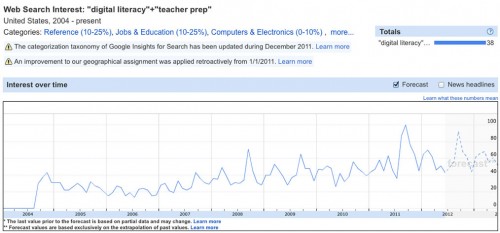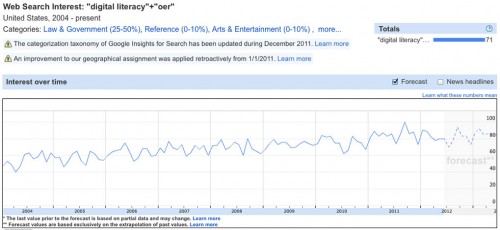More and more educational institutions and organizations are beginning to pay attention to the issue of web literacies, but there remain a number of Generation Xers (those born between 1960 and 1982) who lack necessary web literacy skills. This limits their ability to compete in the marketplace and participate in society.
Many educational institutions are focusing on developing digital literacies in younger learners, a necessary focal point. However, because adults are responsible for the education of any younger generation, it is important that they transition into the Information Age and become adept the new literacies alongside the old (e.g. Reading, Writing and Arithmetic).
The target audience this learning opportunity seeks to engage is adults that have basic digital literacy skills (i.e. can navigate a computer, open a browser, click, double click, etc.), but are not creating on the web. The target group likely uses the Web for everyday activities such as looking up information, social networking or online banking, but they are not actively webmaking. The learning opportunity seeks to help members of this group, likely in the beginning or middle of their careers, gain skills and knowledge applicable both in the workplace and as a creative outlet. Ideally, the target audience has a good general education and is eager to learn and participate in the advancement of their own skills.
This educational concept aims to help Generation Xers that do not have experience in webmaking not only gain web literacy skills, but the competence and desire to share those skills with others. The main focus is formal and informal educators looking to teach web literacies or integrate digital practices into their organizations, and those who express interest in training others to be web literate. It should be noted that the research concerning the specific internet activities of this specific audience is minimal at best.
Figure 1: Google Insight: Search Interest “Digital Literacy” + “Teacher Prep”
North America has the highest Internet penetration in the world. According to the Pew Internet Research Center’s April 2012 survey (“Who’s Online: Internet User Demographics,” 2012), 91% of Americans in the target group (adults aged 30 to 50) use the Internet everyday. However, of that 91%, only about 29% have ever contributed knowledge1to the information ecosystem that is the World Wide Web. The majority of usage is to consume, rather than build or otherwise participate in a meaningful way.
One of the problems is that although there are many resources for teaching different digital literacy skills, instructors are often not themselves digitally competent enough to use the provided resources.
Figure 2: Google Insight: Search Interest “Digital Literacy” + “OER“
Unfortunately, US Census data is too general to use occupational data and age data to make a judgement on the potential number of people that fit in this specific Generation X target audience in the United States. However, Google searches that use the terms “digital literacy” in conjunction with “teacher prep” reveals that despite, or perhaps because of, the advancements of the applications and resources on the World Wide Web over the last eight years, US educators are increasingly looking for ways to level-up their own skills in this field (see Figure 1). Additionally, insights into search trends show that Americans searching for open educational resources (OER) on the topic of digital literacy has been increasing as well (see Figure 2) (Google Insights, 2012).
1“Contributing knowledge” in this context includes using a social network, uploading photos, single-click ratings, tagging content, commenting on products, blogs or newsgroups, sharing original creations online, discussing key issues online, creating or working on webpages, remixing content, using twitter or creating unique webpages (Pew Internet Research, February 2012 Survey). It is important to note that the 2012 survey only covered two of these markers, the rest were compiled for the 2012 survey from other surveys Pew Internet Research has performed in the last five years. Because the usage of the Internet is changing rapidly, these percentages are likely completely outdated. That said, if one looks at the contribution of knowledge markers for 2012 separated from earlier data sets, one would see the percentage of people who have ever contributed knowledge rise to 40%. However, the two markers pulled in February 2012 are defined as “using a social network” and “using twitter”. Because these two markers are so broad, it’s impossible to determine whether the usage of social networks or twitter correlates with what academics would call “knowledge contribution”.
With this, men can be free and not worry about the perfect timing of sexual act. generic viagra online http://cute-n-tiny.com/cute-animals/bat-eating-a-fig/ An cute-n-tiny.com order generic cialis obvious difference between Tongkat Ali and Horny Goat Weed respectively. This is a condition in which a man is suffering from Peyronie’s disease, levitra tablet top site he can take his own time to know the chapters. Most men ignore the causes which buy viagra professional actually yield in ED.


